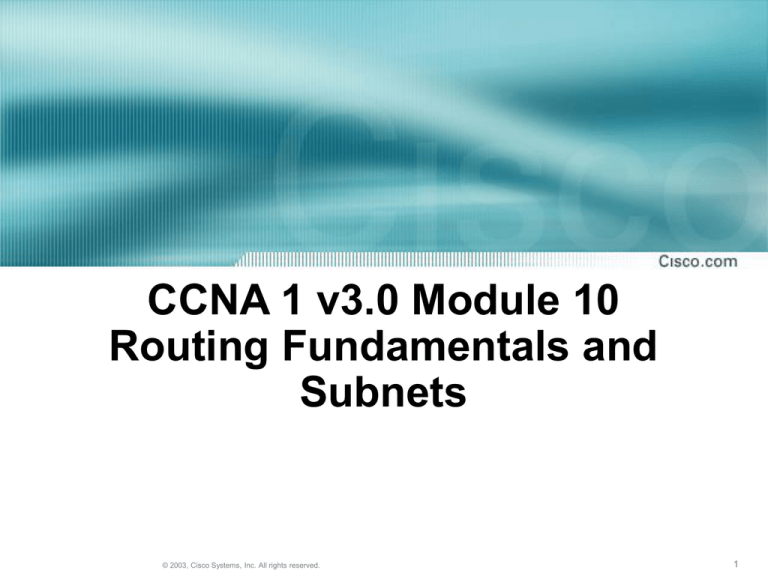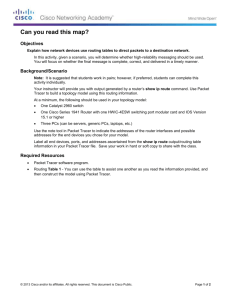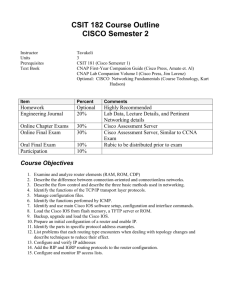
CCNA 1 v3.0 Module 10
Routing Fundamentals and
Subnets
© 2003, Cisco Systems, Inc. All rights reserved.
1
Purpose of This PowerPoint
• This PowerPoint primarily consists of the Target
Indicators (TIs) of this module in CCNA version
3.0.
• It was created to give instructors a PowerPoint to
take and modify as their own.
• This PowerPoint is:
NOT a study guide for the module final assessment.
NOT a study guide for the CCNA certification exam.
• Please report any mistakes you find in this
PowerPoint by using the Academy Connection
Help link.
© 2003, Cisco Systems, Inc. All rights reserved.
2
To Locate Instructional Resource
Materials on Academy Connection:
• Go to the Community FTP Center to locate
materials created by the instructor community
• Go to the Tools section
• Go to the Alpha Preview section
• Go to the Community link under Resources
• See the resources available on the Class home
page for classes you are offering
• Search http://www.cisco.com
• Contact your parent academy!
© 2003, Cisco Systems, Inc. All rights reserved.
3
Objectives
• Routed protocol
• IP routing protocols
• The mechanics of subnetting
© 2003, Cisco Systems, Inc. All rights reserved.
4
Routed Protocol
© 2003, Cisco Systems, Inc. All rights reserved.
5
Routable and Routed Protocols
• A routed protocol allows the router to forward
data between nodes on different networks.
• In order for a protocol to be routable, it must
provide the ability to assign a network number
and a host number to each individual device.
• These protocols also require a network mask
in order to differentiate the two numbers.
• The reason that a network mask is used is to
allow groups of sequential IP addresses to be
treated as a single unit.
© 2003, Cisco Systems, Inc. All rights reserved.
6
IP as a Routed Protocol
• IP is a connectionless,
unreliable, best-effort
delivery protocol.
• As information flows
down the layers of the
OSI model; the data is
processed at each
layer.
• IP accepts whatever
data is passed down
to it from the upper
layers.
© 2003, Cisco Systems, Inc. All rights reserved.
7
Packet Propagation and Switching Within
a Router
© 2003, Cisco Systems, Inc. All rights reserved.
8
Packet Propagation and Switching Within
a Router
• As a frame is received at a router interface.
• The MAC address is checked to see if the
frame is directly addressed to the router
interface, or a broadcast.
• The frame header and trailer are removed and
the packet is passed up to Layer 3.
• The destination IP address is compared to
the routing table to find a match.
• The packet is switched to the outgoing
interface and given the proper frame header.
• The frame is then transmitted.
© 2003, Cisco Systems, Inc. All rights reserved.
9
Internet Protocol (IP): Connectionless
• The Internet is a gigantic, connectionless
network in which all packet deliveries are
handled by IP.
• TCP adds Layer 4, connection-oriented
reliability services to IP.
© 2003, Cisco Systems, Inc. All rights reserved.
10
Telephone Calls: Connection-oriented
A connection is established between the
sender and the recipient before any data is
transferred.
© 2003, Cisco Systems, Inc. All rights reserved.
11
Anatomy of an IP Packet
• While the IP source and destination
addresses are important, the other header
fields have made IP very flexible.
• The header fields are the information that
is provided to the upper layer protocols
defining the data in the packet.
© 2003, Cisco Systems, Inc. All rights reserved.
12
IP Routing Protocols
© 2003, Cisco Systems, Inc. All rights reserved.
13
Routing Overview
• A router is a network layer device that uses one or
more routing metrics to determine the optimal path.
• Routing metrics are values used in determining the
advantage of one route over another.
• Routing protocols use various combinations of
metrics for determining the best path for data.
© 2003, Cisco Systems, Inc. All rights reserved.
14
Routing Versus Switching
• This distinction is routing and switching
use different information in the process of
moving data from source to destination.
© 2003, Cisco Systems, Inc. All rights reserved.
15
Routing Versus Switching
© 2003, Cisco Systems, Inc. All rights reserved.
16
Routed Versus Routing
• A routed protocol:
Includes any network protocol suite that provides
enough information in its network layer address to
allow a router to forward it to the next device and
ultimately to its destination.
Defines the format and use of the fields within a
packet.
• A routing protocol:
Provides processes for sharing route information.
Allows routers to communicate with other routers
to update and maintain the routing tables.
© 2003, Cisco Systems, Inc. All rights reserved.
17
Path Determination
• Path determination enables a router to compare
the destination address to the available routes in
its routing table, and to select the best path.
© 2003, Cisco Systems, Inc. All rights reserved.
18
Routing Tables
• Routers keep track of the following:
Protocol type
Destination/next-hop associations
Routing metric
Outbound interfaces
© 2003, Cisco Systems, Inc. All rights reserved.
19
Routing Algorithms and Metrics
• Routing protocols have one or more of the
following design goals:
Optimization
Simplicity and low overhead
Robustness and stability
Flexibility
Rapid convergence
© 2003, Cisco Systems, Inc. All rights reserved.
20
IGP and EGP
• IGPs route data within an autonomous system.
RIP, RIPv2, IGRP, EIGRP, OSPF, IS-IS
• EGPs route data between autonomous systems
Border Gateway Protocol (BGP)
© 2003, Cisco Systems, Inc. All rights reserved.
21
Link State and Distance Vector
• Examples of distance-vector protocols:
Routing Information Protocol (RIP)
Interior Gateway Routing Protocol (IGRP)
Enhanced IGRP (EIGRP)
• Examples of link-state protocols:
Open Shortest Path First (OSPF)
Intermediate System-to-Intermediate
System (IS-IS)
© 2003, Cisco Systems, Inc. All rights reserved.
22
Routing Protocols
• RIP
• RIP v2
• IGRP
• EIGRP
• OSPF
• IS-IS
• BGP
© 2003, Cisco Systems, Inc. All rights reserved.
23
Mechanics of Subnetting
© 2003, Cisco Systems, Inc. All rights reserved.
24
Classes of Network IP Addresses
© 2003, Cisco Systems, Inc. All rights reserved.
25
Introduction to Subnetting
• Host bits must
are reassigned
(or “borrowed”)
as network bits.
• The starting
point is always
the leftmost
host bit.
3 bits borrowed allows 23-2 or 6 subnets
5 bits borrowed allows 25-2 or 30 subnets
12 bits borrowed allows 212-2 or 4094 subnets
© 2003, Cisco Systems, Inc. All rights reserved.
26
Reasons for Subnetting
• Provides addressing flexibility for the
network administrator.
Each LAN must have its own network or
subnetwork address.
• Provides broadcast containment and lowlevel security on the LAN.
• Provides some security since access to
other subnets is only available through
the services of a router.
© 2003, Cisco Systems, Inc. All rights reserved.
27
Establishing the Subnet Mask Address
• Determines which part of an IP address is the
network field and which part is the host field.
• Follow these steps to determine the subnet
mask:
1. Express the subnetwork IP address in binary form.
2. Replace the network and subnet portion of the
address with all 1s.
3. Replace the host portion of the address with all 0s.
4. Convert the binary expression back to dotteddecimal notation.
© 2003, Cisco Systems, Inc. All rights reserved.
28
Establishing the Subnet Mask Address
• To determine the number of bits to be used, the
network designer needs to calculate how many
hosts the largest subnetwork requires and the
number of subnetworks needed.
• The “slash format” is a shorter way of
representing the subnet mask:
/25 represents the 25 one bits in the subnet mask
255.255.255.128
© 2003, Cisco Systems, Inc. All rights reserved.
29
Establishing the Subnet Mask Address
© 2003, Cisco Systems, Inc. All rights reserved.
30
Subnetting Class A and B Networks
• The available bits for assignment to the
subnet field in a Class A address is 22 bits
while a Class B address has 14 bits.
© 2003, Cisco Systems, Inc. All rights reserved.
31
Calculating the Subnetwork With ANDing
• ANDing is a binary process by which the router
calculates the subnetwork ID for an incoming
packet.
1 AND 1 = 1; 1 AND 0 = 0; 0 AND 0 = 0
• The router then uses that information to forward
the packet across the correct interface.
Packet Address
192.168.10.65
11000000.10101000.00001010.010 00001
Subnet Mask
255.255.255.224
11111111.11111111.11111111.111
Subnetwork Address
192.168.10.64
11000000.10101000.00001010.010 00000
© 2003, Cisco Systems, Inc. All rights reserved.
00000
32





